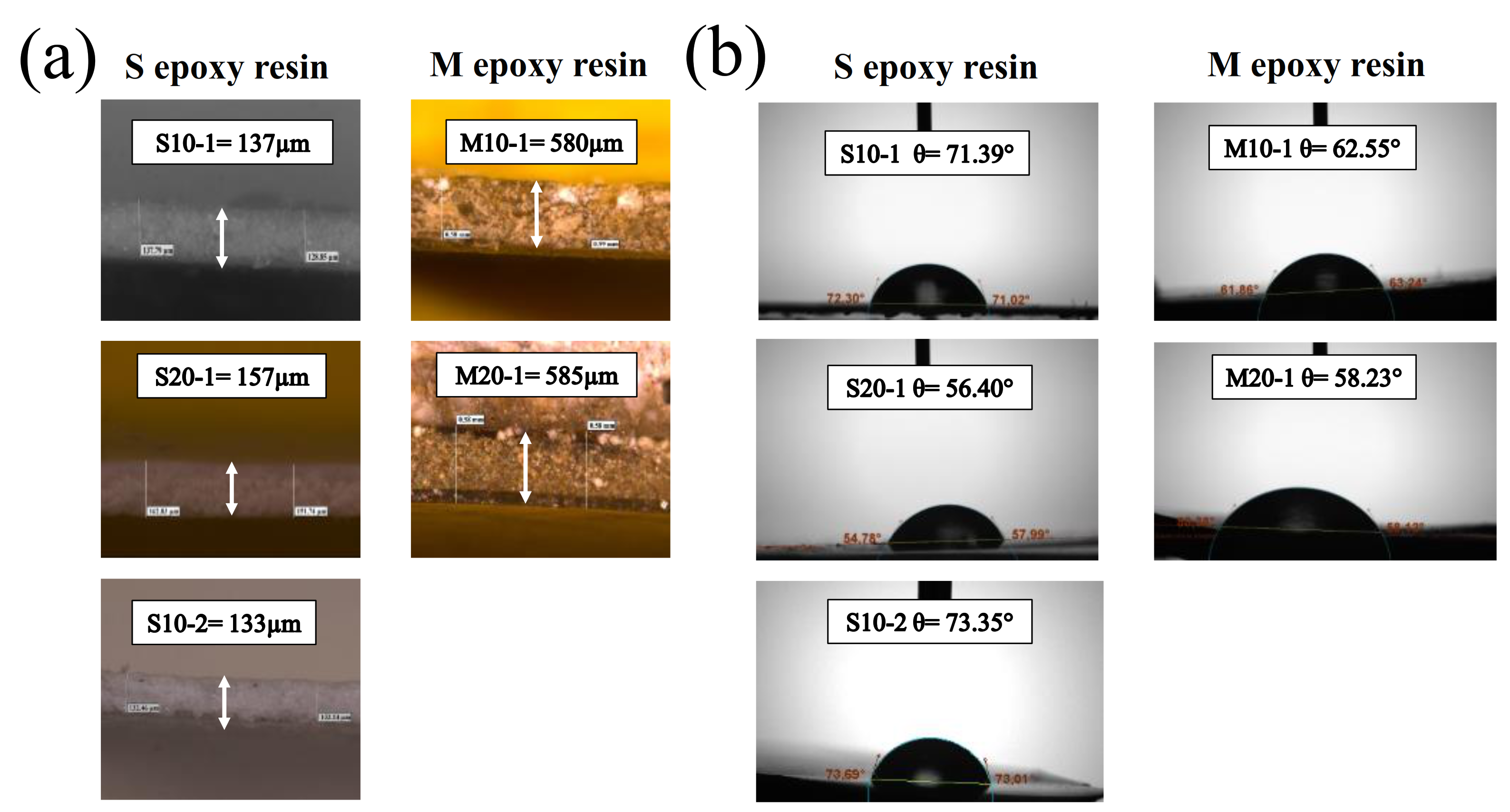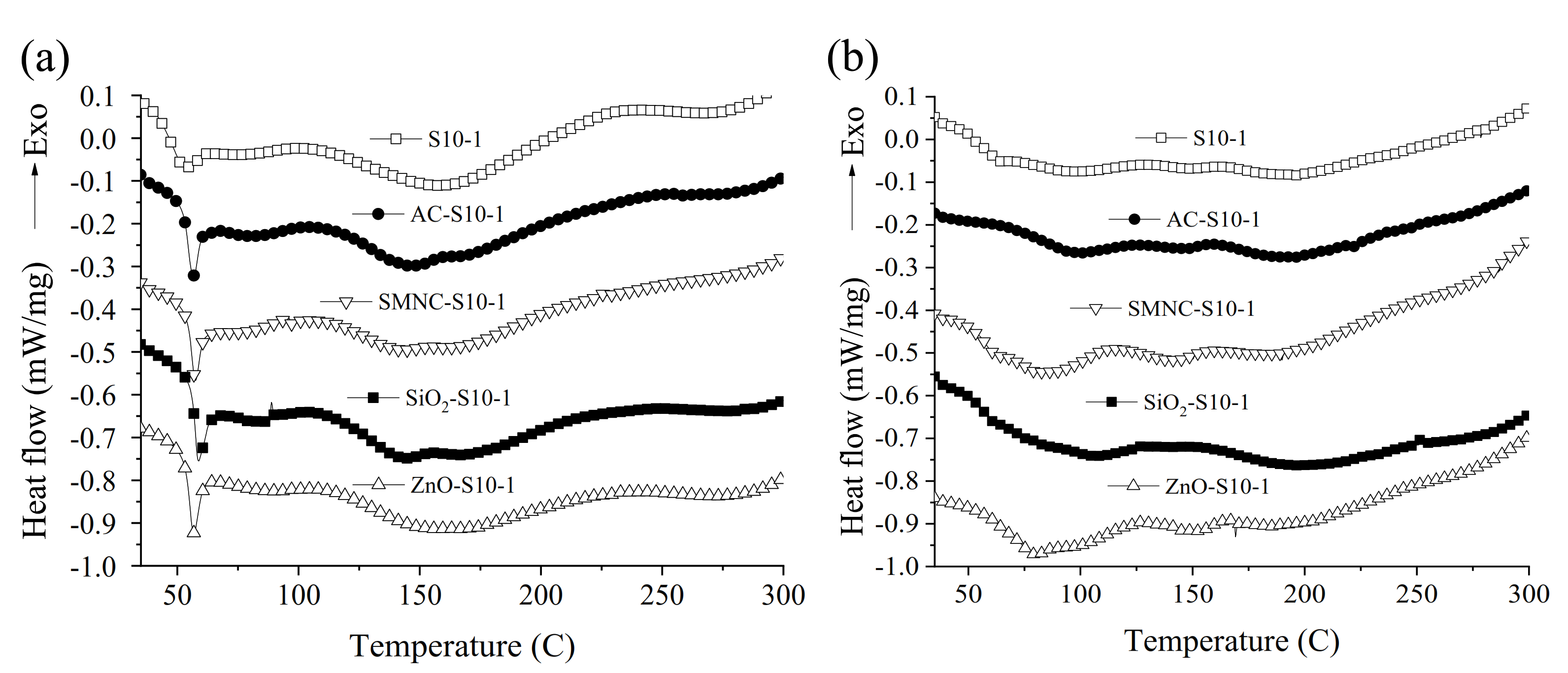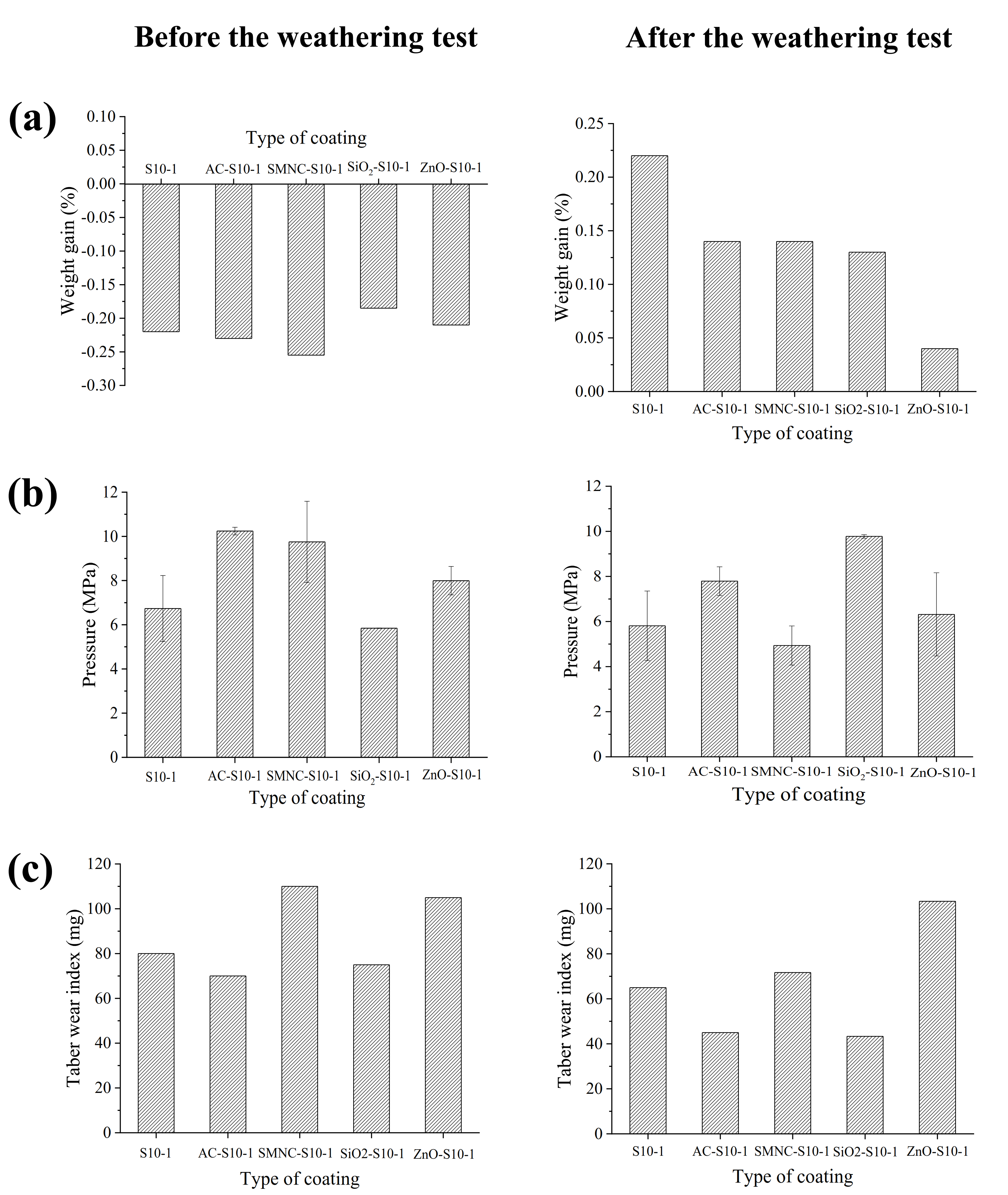Long-Term Performance of Nanomodified Coated Concrete Structures under Hostile Marine Climate Conditions
Abstract
1. Introduction
- i.
- high pressure steam cured concrete elements,
- ii.
- the use of a suitable concrete specification, cover thickness, and compaction of construction joints;
- iii.
- the adoption of alternative materials to steel as reinforcement bars;
- iv.
- the use of concrete protective coatings; or
- v.
- cathodic barrier techniques.
2. Materials and Methods
2.1. Materials and Concrete Specimen Preparation
- i.
- a cement-based epoxy resin (SE);
- ii.
- a bisphenol-A based epoxy resin; and
- iii.
- a polyol-based epoxy resin.
2.2. Optimization and Characterization of the Coating Methodology
- i.
- spatula printing;
- ii.
- paintbrush impregnation;
- iii.
- paintroller impregnation; and
- iv.
- dip-coating methodology.
2.3. Characterization of Materials
2.4. Optimization of the NP Incorporation into the Coatings
3. Results and Discussion
3.1. Characterization and Optimization of the Coating Methodology
- i.
- type of resin;
- ii.
- coating time;
- iii.
- and number of the coating immersions;
3.2. Characterization of Commercial Nanoparticles
3.3. Optimization of Commercial Nanoparticle Incorporation into the Coating
3.4. Characterization of the Incorporation of NPs into the Part B of the Resin
- i.
- well dispersed materials (TSI < 5);
- ii.
- part of the material was deposited at the bottom of the flask and could be easily re-dispersed (5 < TSI < 20);
- iii.
- the material was mostly sedimented (TSI > 20) [45].
3.5. Characterization of the Coatings before and after the Weathering Test
3.6. Results of Water Permeability, Pull-off, and Taber Test Before and After Weathering Test
4. Conclusions
Supplementary Materials
Author Contributions
Funding
Data Availability Statement
Acknowledgments
Conflicts of Interest
References
- Parimalam, M.; Islam, M.R.; Yunus, R.M. Effects of nanosilica, zinc oxide, titatinum oxide on the performance of epoxy hybrid nanocoating in presence of rubber latex. Polym. Test. 2018, 70, 197–207. [Google Scholar] [CrossRef]
- Pour-Ali, S.; Dehghanian, C.; Kosari, A. In situ synthesis of polyaniline-camphorsulfonate particles in an epoxy matrix for corrosion protection of mild steel in NaCl solution. Corros. Sci. 2014, 85, 204–214. [Google Scholar] [CrossRef]
- Gu, H.; Ma, C.; Gu, J.; Guo, J.; Yan, X.; Huang, J.; Zhang, Q.; Guo, Z. An overview of multifunctional epoxy nanocomposites. J. Mater. Chem. C 2016, 4, 5890–5906. [Google Scholar] [CrossRef]
- Castrillo, P.D.; Olmos, D.; Sue, H.J.; González-Benito, J. Mechanical characterization and fractographic study of epoxy-kaolin polymer nanocomposites. Compos. Struct. 2015, 133, 70–76. [Google Scholar] [CrossRef]
- Zhu, J.; Wei, S.; Ryu, J.; Sun, L.; Luo, Z.; Guo, Z. Magnetic epoxy resin nanocomposites reinforced with core—Shell structured Fe@FeO nanoparticles: Fabrication and property analysis. ACS Appl. Mater. Interfaces 2010, 2, 2100–2107. [Google Scholar] [CrossRef]
- Huang, T.C.; Su, Y.A.; Yeh, T.C.; Huang, H.Y.; Wu, C.P.; Huang, K.Y.; Chou, Y.C.; Yeh, J.M.; Wei, Y. Advanced anticorrosive coatings prepared from electroactive epoxy-SiO2 hybrid nanocomposite materials. Electrochim. Acta 2011, 56, 6142–6149. [Google Scholar] [CrossRef]
- Liu, Y.L.; Hsu, C.Y.; Wei, W.L.; Jeng, R.J. Preparation and thermal properties of epoxy-silica nanocomposites from nanoscale colloidal silica. Polymer 2003, 44, 5159–5167. [Google Scholar] [CrossRef]
- Li, G.; Yue, J.; Guo, C.; Ji, Y. Influences of modified nanoparticles on hydrophobicity of concrete with organic film coating. Constr. Build. Mater. 2018, 169, 1–7. [Google Scholar] [CrossRef]
- McGrath, L.M.; Parnas, R.S.; King, S.H.; Schroeder, J.L.; Fischer, D.A.; Lenhart, J.L. Investigation of the thermal, mechanical, and fracture properties of alumina-epoxy composites. Polymer 2008, 49, 999–1014. [Google Scholar] [CrossRef]
- Tomić, M.D.; Dunjić, B.; Likić, V.; Bajat, J.; Rogan, J.; Djonlagić, J. The use of nanoclay in preparation of epoxy anticorrosive coatings. Prog. Org. Coat. 2014, 77, 518–527. [Google Scholar] [CrossRef]
- Caselis, J.L.V.; Rosas, E.R.; Juárez, J.D.S.; Aguilar, J.A.G.; Cantú, M.S.; Xometl, O.; Sánchez, M. The use of montmorillonite organoclay in preparation of UV-cured DGBA epoxy anticorrosive coatings. Corros. Eng. Sci. Technol. 2018, 53, 362–369. [Google Scholar] [CrossRef]
- Ho, M.W.; Lam, C.K.; Lau, K.T.; Ng, D.H.L.; Hui, D. Mechanical properties of epoxy-based composites using nanoclays. Compos. Struct. 2006, 75, 415–421. [Google Scholar] [CrossRef]
- Rostami, M.; Rasouli, S.; Ramezanzadeh, B.; Askari, A. Electrochemical investigation of the properties of Co doped ZnO nanoparticle as a corrosion inhibitive pigment for modifying corrosion resistance of the epoxy coating. Corros. Sci. 2014, 88, 387–399. [Google Scholar] [CrossRef]
- Li, Y.Q.; Fu, S.Y.; Mai, Y.W. Preparation and characterization of transparent ZnO/epoxy nanocomposites with high-UV shielding efficiency. Polymer 2006, 47, 2127–2132. [Google Scholar] [CrossRef]
- Hooda, A.; Goyat, M.S.; Gupta, R.; Prateek, M.; Agrawal, M.; Biswas, A. Synthesis of nano-textured polystyrene/ZnO coatings with excellent transparency and superhydrophobicity. Mater. Chem. Phys. 2017, 193, 447–452. [Google Scholar] [CrossRef]
- Zhu, J.; Wei, S.; Ryu, J.; Budhathoki, M.; Liang, G.; Guo, Z. In situ stabilized carbon nanofiber (CNF) reinforced epoxy nanocomposites. J. Mater. Chem. 2010, 20, 4937–4948. [Google Scholar] [CrossRef]
- Qing, Y.; Wang, X.; Zhou, Y.; Huang, Z.; Luo, F.; Zhou, W. Enhanced microwave absorption of multi-walled carbon nanotubes/epoxy composites incorporated with ceramic particles. Compos. Sci. Technol. 2014, 102, 161–168. [Google Scholar] [CrossRef]
- Cui, L.J.; Geng, H.Z.; Wang, W.Y.; Chen, L.T.; Gao, J. Functionalization of multi-wall carbon nanotubes to reduce the coefficient of the friction and improve the wear resistance of multi-wall carbon nanotube/epoxy composites. Carbon N. Y. 2013, 54, 277–282. [Google Scholar] [CrossRef]
- Zaman, I.; Phan, T.T.; Kuan, H.C.; Meng, Q.; La, L.T.B.; Luong, L.; Youssf, O.; Ma, J. Epoxy/graphene platelets nanocomposites with two levels of interface strength. Polymer 2011, 52, 1603–1611. [Google Scholar] [CrossRef]
- Rafiee, M.A.; Rafiee, J.; Wang, Z.; Song, H.; Yu, Z.Z.; Koratkar, N. Enhanced mechanical properties of nanocomposites at low graphene content. ACS Nano 2009, 3, 3884–3890. [Google Scholar] [CrossRef] [PubMed]
- Tadda, M.A.; Ahsan, A.; Shitu, A.; ElSergany, M.; Arunkumar, T.; Jose, B.; Razzaque, M.A.; Daud, N. A Review on Activated Carbon: Process, Application and Prospects. J. Adv. Civ. Eng. Pract. Res. 2016, 2, 7–13. [Google Scholar]
- Mai, Y.W.; Yu, Z.Z. Polymer Nanocomposites; Woodhead Publishing Series in Composites Science and Engineering; Elsevier Science: Amsterdam, The Netherlands, 2006; ISBN 9781845691127. [Google Scholar]
- Liu, Y.L.; Li, S.H. Using silica nanoparticles as curing reagents for epoxy resins to form epoxy-silica nanocomposites. J. Appl. Polym. Sci. 2005, 95, 1237–1245. [Google Scholar] [CrossRef]
- Becker, L.O.; Simon, G.P. Epoxy nanocomposites based on layered silicates and other nanostructured fillers. In Polymer Nanocomposites; Mai, Y.-W., Yu, Z.-Z., Eds.; Woodhead Publishing: Cambridge, UK, 2006; pp. 29–56. [Google Scholar]
- ASTM. D 5894-05. Standard Practice for Cyclic Salt Fog/UV Exposure of Painted Metal, (Alternating Exposures in a Fog/Dry Cabinet and a UV/Condensation Caminet). ASTM Stand. 2005, 3. [Google Scholar] [CrossRef]
- UNE. UNE-EN 1062-3: Pinturas y Barnices. Materiales de Recubrimiento y Sistemas de Recubrimiento Para Albañería Exterior y Hormigón. Parte 3: Determinación de la Permeabilidad del Agua Líquida; UNE Normalización Española: Madrid, Spain, 2008. [Google Scholar]
- ASTM. ASTM D4541-09: Standard Test Method for Pull-Off Strength of Coatings Using Portable Adhesion. ASTM Int. 2014, 1–16. [Google Scholar] [CrossRef]
- Paint, T.; Materials, R.; Metals, F.; Coat, N. ASTM D4060-10. Standard Test Method for Abrasion Resistance of Organic Coatings by the Taber; ASTM International: West Conshohocken, PA, USA, 2010; pp. 1–5. [Google Scholar] [CrossRef]
- Szymanowski, J.; Sadowski, Ł. Functional and adhesive properties of cement-based overlays modified with amorphous silica nanospheres. J. Adhes. 2020, 96, 207–228. [Google Scholar] [CrossRef]
- Miturska, I.; Rudawska, A.; Müller, M.; Valášek, P. The influence of modification with natural fillers on the mechanical properties of epoxy adhesive compositions after storage time. Materials 2020, 13, 291. [Google Scholar] [CrossRef]
- Lipińska, M. Comparative study of various intercalant modified clay/rubber nanocomposites prepared by melt-compounding. Int. J. Res. Manag. Sci. 2017, 4, 103–117. [Google Scholar] [CrossRef]
- Esteban-Arranz, A.; Compte-Tordesillas, D.; Muñoz-Andrés, V.; Pérez-Cadenas, M.; Guerrero-Ruiz, A. Effect of surface, structural and textural properties of graphenic materials over cooperative and synergetic adsorptions of two chloroaromatic compounds from aqueous solution. Catal. Today 2018, 301, 104–111. [Google Scholar] [CrossRef]
- Calabi-Floody, M.; Bendall, J.S.; Jara, A.A.; Welland, M.E.; Theng, B.K.G.; Rumpel, C.; Mora, M.d.l.L. Nanoclays from an Andisol: Extraction, properties and carbon stabilization. Geoderma 2011, 161, 159–167. [Google Scholar] [CrossRef]
- Tatzber, M.; Stemmer, M.; Spiegel, H.; Katzlberger, C.; Haberhauer, G.; Mentler, A.; Gerzabek, M.H. FTIR-spectroscopic characterization of humic acids and humin fractions obtained by advanced NaOH, Na4P2O7, and Na2CO3 extraction procedures. J. Plant Nutr. Soil Sci. 2007, 170, 522–529. [Google Scholar] [CrossRef]
- Yuan, P.; Southon, P.D.; Liu, Z.; Green, M.E.R.; Hook, J.M.; Antill, S.J.; Kepert, C.J. Functionalization of halloysite clay nanotubes by grafting with γ-aminopropyltriethoxysilane. J. Phys. Chem. C 2008, 112, 15742–15751. [Google Scholar] [CrossRef]
- Pasbakhsh, P.; Ismail, H.; Fauzi, M.N.A.; Bakar, A.A. EPDM/modified halloysite nanocomposites. Appl. Clay Sci. 2010, 48, 405–413. [Google Scholar] [CrossRef]
- Liang, Y.; Ouyang, J.; Wang, H.; Wang, W.; Chui, P.; Sun, K. Synthesis and characterization of core-shell structured SiO2 @YVO 4:Yb3+, Er3+ microspheres. Appl. Surf. Sci. 2012, 258, 3689–3694. [Google Scholar] [CrossRef]
- Méndez-Vivar, J.; Mendoza-Bandala, A. Spectroscopic study on the early stages of the polymerization of hybrid TEOS-RSi (OR’)3 sols. J. Non-Cryst. Solids 2000, 261, 127–136. [Google Scholar] [CrossRef]
- San Andrés, E.; Del Prado, A.; Martínez, F.L.; Mártil, I.; Bravo, D.; López, F.J. Rapid thermal annealing effects on the structural properties and density of defects in SiO2 and SiNx: H films deposited by electron cyclotron resonance. J. Appl. Phys. 2000, 87, 1187–1192. [Google Scholar] [CrossRef]
- Habeeb Alshamsi, H.A.; Hussein, B.S. Hydrothermal preparation of silver doping zinc oxide nanoparticles: Studys, characterization and photocatalytic activity. Orient. J. Chem. 2018, 34, 1898–1907. [Google Scholar] [CrossRef]
- Bagherzadeh, A.; Jamshidi, M.; Monemian, F. Investigating mechanical and bonding properties of micro/nano filler containing epoxy adhesives for anchoring steel bar in concrete. Constr. Build. Mater. 2020, 240, 117979. [Google Scholar] [CrossRef]
- Jamal-Omidi, M.; ShayanMehr, M. Improving the dispersion of SWNT in epoxy resin through a simple Multi-Stage method. J. King Saud Univ. Sci. 2019, 31, 202–208. [Google Scholar] [CrossRef]
- Grossiord, N. A Latex-Based Concept for Making Carbon Nanotube/Polymer Nanocomposites; Technische Universiteit Eindhoven: Eindhoven, The Netherlands, 2007. [Google Scholar]
- Romero, A.; Lavin-Lopez, M.P.; Sánchez-Silva, M.L.; Valverde, J.L.; Paton-Carrero, A. Effects of oxidizing procedures on carbon nanofibers surface and dispersability in an epoxy resin. Mater. Chem. Phys. 2020, 243, 122571. [Google Scholar] [CrossRef]
- Dai, J.; Wang, G.; Ma, L.; Wu, C. Study on the surface energies and dispersibility of graphene oxide and its derivatives. J. Mater. Sci. 2015, 50, 3895–3907. [Google Scholar] [CrossRef]
- Da̧browski, A.; Podkościelny, P.; Hubicki, Z.; Barczak, M. Adsorption of phenolic compounds by activated carbon—A critical review. Chemosphere 2005, 58, 1049–1070. [Google Scholar] [CrossRef]
- Zhou, H.; Chen, R.; Liu, Q.; Liu, J.; Yu, J.; Wang, C.; Zhang, M.; Liu, P.; Wang, J. Fabrication of ZnO/epoxy resin superhydrophobic coating on AZ31 magnesium alloy. Chem. Eng. J. 2019, 368, 261–272. [Google Scholar] [CrossRef]
- Ammar, S.; Ramesh, K.; Vengadaesvaran, B.; Ramesh, S.; Arof, A.K. Amelioration of anticorrosion and hydrophobic properties of epoxy/PDMS composite coatings containing nano ZnO particles. Prog. Org. Coat. 2016, 92, 54–65. [Google Scholar] [CrossRef]
- Tsagaropoulos, G.; Eisenberg, A. Dynamic Mechanical Study of the Factors Affecting the Two Glass Transition Behavior of Filled Polymers. Similarities and Differences with Random Ionomers. Macromolecules 1995, 28, 6067–6077. [Google Scholar] [CrossRef]
- Khan, R.; Azhar, M.R.; Anis, A.; Alam, M.A.; Boumaza, M.; Al-Zahrani, S.M. Facile synthesis of epoxy nanocomposite coatings using inorganic nanoparticles for enhanced thermo-mechanical properties: A comparative study. J. Coat. Technol. Res. 2016, 13, 159–169. [Google Scholar] [CrossRef]
- Stojanovic, D.; Orlovic, A.; Markovic, S.; Radmilovic, V.; Uskokovic, P.S.; Aleksic, R. Nanosilica/PMMA composites obtained by the modification of silica nanoparticles in a supercritical carbon dioxide-ethanol mixture. J. Mater. Sci. 2009, 44, 6223–6232. [Google Scholar] [CrossRef]
- Evtushenko, Y.M.; Ivanov, V.M.; Zaitsev, B.E. Determination of Epoxide and Hydroxyl Groups in Epoxide Resins by IR Spectrometry. J. Anal. Chem. 2003, 58, 347–350. [Google Scholar] [CrossRef]
- Meure, S.; Wu, D.Y.; Furman, S.A. FTIR study of bonding between a thermoplastic healing agent and a mendable epoxy resin. Vib. Spectrosc. 2010, 52, 10–15. [Google Scholar] [CrossRef]
- Grassie, N.; Guy, M.I.; Tennent, N.H. Degradation of epoxy polymers: Part 4-Thermal degradation of bisphenol-A diglycidyl ether cured with ethylene diamine. Polym. Degrad. Stab. 1986, 14, 125–137. [Google Scholar] [CrossRef]
- Rose, N.; Le Bras, M.; Bourbigot, S.; Delobel, R. Thermal oxidative degradation of epoxy resins: Evaluation of their heat resistance using invariant kinetic parameters. Polym. Degrad. Stab. 1994, 45, 387–397. [Google Scholar] [CrossRef]
- Nguyen, T.A.; Nguyen, H.; Nguyen, T.V.; Thai, H.; Shi, X. Effect of nanoparticles on the thermal and mechanical properties of epoxy coatings. J. Nanosci. Nanotechnol. 2016, 16, 9874–9881. [Google Scholar] [CrossRef]
- Khotbehsara, M.M.; Manalo, A.; Aravinthan, T.; Turner, J.; Ferdous, W.; Hota, G. Effects of ultraviolet solar radiation on the properties of particulate-filled epoxy based polymer coating. Polym. Degrad. Stab. 2020, 181, 109352. [Google Scholar] [CrossRef]
- El-Fattah, M.A.; El Saeed, A.M.; El-Ghazawy, R.A. Chemical interaction of different sized fumed silica with epoxy via ultrasonication for improved coating. Prog. Org. Coat. 2019, 129, 1–9. [Google Scholar] [CrossRef]
- Qiu, R.; Zhang, D.; Mo, Y.; Song, L.; Brewer, E.; Huang, X.; Xiong, Y. Photocatalytic activity of polymer-modified ZnO under visible light irradiation. J. Hazard. Mater. 2008, 156, 80–85. [Google Scholar] [CrossRef] [PubMed]
- Nguyen, T.V.; Nguyen, T.A.; Nguyen, T.H. The Synergistic Effects of SiO2 Nanoparticles and Organic Photostabilizers for Enhanced Weathering Resistance of Acrylic Polyurethane Coating. J. Compos. Sci. 2020, 4, 23. [Google Scholar] [CrossRef]





| (a) | NPs-S10-1 before the Weathering Test | |||||
| Technique | Parameter | S-10 | AC-S10-1 | SMNC-S10-1 | SiO2-S10-1 | ZnO-S10-1 |
| Contact Angle | θ (°) | 71.6 | 77.8 | 88.7 | 63.8 | 59.7 |
| Optical Loop | Thickness (µm) | 137.8 | 93.2 | 85.2 | 182.7 | 164.4 |
| DSC-N2 | Tg1 (°C) | 52.7 | 56.9 | 57.6 | 58.6 | 56.8 |
| TGA-N2 | T5% (°C) | 160.3 | 146.8 | 152.5 | 163.1 | 166.1 |
| T40% (°C) | 400.1 | 407.2 | 419.7 | 405.3 | 404.2 | |
| Weight Lossstage1 (%) | 10.4 | 11.9 | 10.4 | 10.4 | 10.4 | |
| Weight Lossstage2 (%) | 53.1 | 47.4 | 45.9 | 48.4 | 49.2 | |
| Residue (%) | 21.6 | 24.5 | 23.9 | 24.3 | 24.3 | |
| TGA-Air | T5% (°C) | 138.1 | 134.8 | 142.3 | 147.2 | 154.3 |
| T40% (°C) | 391.7 | 382.8 | 389.1 | 389.2 | 385.1 | |
| Weight Lossstage1 (%) | 12.2 | 14.6 | 12.8 | 12.5 | 12.5 | |
| Weight Lossstage2 (%) | 41.7 | 40.6 | 41.4 | 42.6 | 41.7 | |
| Residue (%) | 20.6 | 16.3 | 15.1 | 23.1 | 22.6 | |
| (b) | NPs-S10-1 after the Weathering Test | |||||
| Technique | Parameter | S-10 | AC-S10-1 | SMNC-S10-1 | SiO2-S10-1 | ZnO-S10-1 |
| Contact Angle | θ (°) | 55.7 | 66.1 | 71.4 | 58.8 | 77.9 |
| Optical Loop | Thickness (µm) | 127.4 | 112.7 | 113.5 | 129.5 | 84.1 |
| DSC-N2 | Tg1 (°C) | 63.8 | 98.5 | 80.9 | 104.9 | 79.7 |
| TGA-N2 | T5% (°C) | 201.7 | 195.2 | 191.3 | 212.7 | 206.0 |
| T40% (°C) | 412.1 | 414.5 | 417.5 | 411.2 | 410.7 | |
| Weight Lossstage1 (%) | 8.4 | 7.3 | 7.3 | 8.4 | 7.3 | |
| Weight Lossstage2 (%) | 50.1 | 46.6 | 46.6 | 48.1 | 46.7 | |
| Residue (%) | 23.5 | 26.6 | 26.2 | 26.5 | 28.5 | |
| TGA-Air | T5% (°C) | 175.5 | 177.1 | 154.3 | 173.1 | 171.3 |
| T40% (°C) | 401.5 | 404.8 | 400.2 | 392.5 | 398.2 | |
| Weight Lossstage1 (%) | 8.7 | 8.7 | 9.9 | 10.7 | 8.7 | |
| Weight Lossstage2 (%) | 41.2 | 37.9 | 39.3 | 44.7 | 41.2 | |
| Residue (%) | 23.3 | 26.5 | 23.2 | 22.1 | 23.1 | |
Publisher’s Note: MDPI stays neutral with regard to jurisdictional claims in published maps and institutional affiliations. |
© 2021 by the authors. Licensee MDPI, Basel, Switzerland. This article is an open access article distributed under the terms and conditions of the Creative Commons Attribution (CC BY) license (http://creativecommons.org/licenses/by/4.0/).
Share and Cite
Esteban-Arranz, A.; de la Osa, A.R.; García-Lorefice, W.E.; Sacristan, J.; Sánchez-Silva, L. Long-Term Performance of Nanomodified Coated Concrete Structures under Hostile Marine Climate Conditions. Nanomaterials 2021, 11, 869. https://doi.org/10.3390/nano11040869
Esteban-Arranz A, de la Osa AR, García-Lorefice WE, Sacristan J, Sánchez-Silva L. Long-Term Performance of Nanomodified Coated Concrete Structures under Hostile Marine Climate Conditions. Nanomaterials. 2021; 11(4):869. https://doi.org/10.3390/nano11040869
Chicago/Turabian StyleEsteban-Arranz, Adrián, Ana Raquel de la Osa, Wendy Eunice García-Lorefice, Javier Sacristan, and Luz Sánchez-Silva. 2021. "Long-Term Performance of Nanomodified Coated Concrete Structures under Hostile Marine Climate Conditions" Nanomaterials 11, no. 4: 869. https://doi.org/10.3390/nano11040869
APA StyleEsteban-Arranz, A., de la Osa, A. R., García-Lorefice, W. E., Sacristan, J., & Sánchez-Silva, L. (2021). Long-Term Performance of Nanomodified Coated Concrete Structures under Hostile Marine Climate Conditions. Nanomaterials, 11(4), 869. https://doi.org/10.3390/nano11040869







